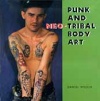Punk and Neo-Tribal Body Art (book): Difference between revisions
(Created page with "<html><div class="mw-content-ltr" dir="ltr" id="mw-content-text" lang="en"><table border="0" class="toccolours" style="width:200px;float:right;margin:10px;"> <tr> <th colspan="2"> <i>Punk and Neo-Tribal Body Art</i> </th></tr> <tr> <th colspan="2"> <a class="image" href="/index.php?title=File:Punneh-cover.jpg"><img alt="Punneh-cover.jpg" height="101" src="/images/thumb/0/0a/Punneh-cover.jpg/100px-Punneh-cover.jpg" width="100"/></a> </th></tr> <tr> <td style="vertical-ali...") |
(Page conversion via llm-mediawiki-rev -jwm) |
||
| Line 1: | Line 1: | ||
{| class="toccolours" style="width:200px;float:right;margin:10px;" | |||
|- | |||
! colspan="2" | ''Punk and Neo-Tribal Body Art'' | |||
|- | |||
! colspan="2" | [[File:Punneh-cover.jpg|thumb|100px|Punneh-cover.jpg]] | |||
|- | |||
|'''Author''' | |||
|Daniel Wojcik | |||
|- | |||
|'''Illustrator''' | |||
| | |||
|- | |||
|'''Genre''' | |||
|Culture Studies | |||
|- | |||
|'''Country''' | |||
|United States | |||
|- | |||
|'''Publisher''' | |||
|University Press of Mississippi | |||
|- | |||
|'''Published''' | |||
|September 1995 | |||
|- | |||
|'''Language''' | |||
|English | |||
|- | |||
|'''Pages''' | |||
|72 | |||
|- | |||
|'''ISBN''' | |||
|0878057358 | |||
|} | |||
'''Punk and Neo-Tribal Body Art''' by ''Daniel Wojcik'' | |||
''From the back:'' | |||
[[Tattooing|Tattooing]], [[Piercing|piercing]], and [[Scarification|scarification]] have been notorious and celebrated forms of body adornment in the punk culture for nearly two decades. Punk rockers assaulted society with in-your-face styles calculated to annoy or horrify. Their do-it-yourself ethos emphasized parody, gender confusion, and forbidden aspects of life. Whether for the goal of asserting one's own identity, shocking the establishment, or expressing personal aesthetics, these once taboo styles of body art have moved into other areas of modern culture. "Neo-tribalism," adapted from non-Western practices of body adornment, has emerged as a new youth and subcultural phenomenon. | |||
Here presented in a book exploring the shock aesthetics of punk and neo-tribalism is a fascinating study of modern-age folklife. Given special focus is [[Perry Farrell|Perry Farrell]], an influential practitioner of neo-tribal body art. This informally taught artist and musician who once lived in the streets of Los Angeles founded the band called Jane's Addiction and created the "Lollapalooza Tour." Understanding the subversive and personal appeal of [[Body_art|body art]] for youth of the Western world is enhanced through understanding such a neo-tribalist figure as Perry Farrell. | |||
Daniel Wojcik is a professor of English and folklore at the University of Oregon. | |||
Latest revision as of 10:17, 17 September 2023
| Punk and Neo-Tribal Body Art | |
|---|---|
| Author | Daniel Wojcik |
| Illustrator | |
| Genre | Culture Studies |
| Country | United States |
| Publisher | University Press of Mississippi |
| Published | September 1995 |
| Language | English |
| Pages | 72 |
| ISBN | 0878057358 |
Punk and Neo-Tribal Body Art by Daniel Wojcik
From the back:
Tattooing, piercing, and scarification have been notorious and celebrated forms of body adornment in the punk culture for nearly two decades. Punk rockers assaulted society with in-your-face styles calculated to annoy or horrify. Their do-it-yourself ethos emphasized parody, gender confusion, and forbidden aspects of life. Whether for the goal of asserting one's own identity, shocking the establishment, or expressing personal aesthetics, these once taboo styles of body art have moved into other areas of modern culture. "Neo-tribalism," adapted from non-Western practices of body adornment, has emerged as a new youth and subcultural phenomenon.
Here presented in a book exploring the shock aesthetics of punk and neo-tribalism is a fascinating study of modern-age folklife. Given special focus is Perry Farrell, an influential practitioner of neo-tribal body art. This informally taught artist and musician who once lived in the streets of Los Angeles founded the band called Jane's Addiction and created the "Lollapalooza Tour." Understanding the subversive and personal appeal of body art for youth of the Western world is enhanced through understanding such a neo-tribalist figure as Perry Farrell.
Daniel Wojcik is a professor of English and folklore at the University of Oregon.
